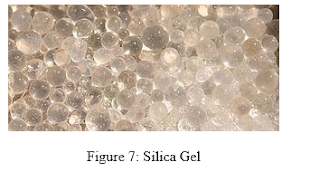Silica is also known silicon dioxide, thus it is an oxide of silicon as shown in (Figure 7) it’s made synthetically from sodium silicate.
Since it adsorbing agent, it can hold water vapor and thus it is classified as the desiccant. It is properties are summarized in (table 1).1 Also, hydrophobic of the solvent is one of the other property that can be added to silica gel. This property leads to form a structure through hydrogen bonding, on which the silica gel is become amorphous and has the ability to become thick for the solvent system. The structural formula is shown in (Figure 8-a), however, the tetrahedral coordination of Si atom with oxygen atoms will yield the structure shown in (Figure 8-b).
Silica is divided into two different types: crystalline and amorphous. The formation of amorphous silica is either by wet and thermal. The wet process is like silica gel and also known as precipitated silica. The thermal process formed fumed silica or pyrogenic silica. The production of silica gel is by the neutralization of a solution of alkali metal silicate with sulfuric acid (gelation). Mixing continues solidification begins; the gelation conditions dictate particle size in the hydrogel, the gel is washed with excess salt. The specific surface areas can be determined then by this procedure. Then silica gel’s pore is filled with water. Silica is used in paints, lacquers, plastics, and paper. The lipid layer is dehydrated by using a silica gel as an insecticide by absorption. Silica is used in cosmetics such as hair color sprays/aerosols. It was also used in non-cosmetic such as, filler in rubber formulations, silica was used as an anti-caking agent in dry powder for the food ingredient. In addition, to maintain flow properties in powder products and to inhibit the separation of components, silica should be used in pharmaceuticals as a thickener in pastes and ointments. This was mentioned by the Cosmetic Ingredient Review Expert Panel members.2
Reference:
1 (23 March 2017).Silica Gel.[online] Available at :https://en.wikipedia.org/wiki/Silica_gel
2 Becker, L. C. (September 25, 2009). Safety Assessment of Silica and Related Cosmetic Ingredients. Washington.







No comments:
Post a Comment